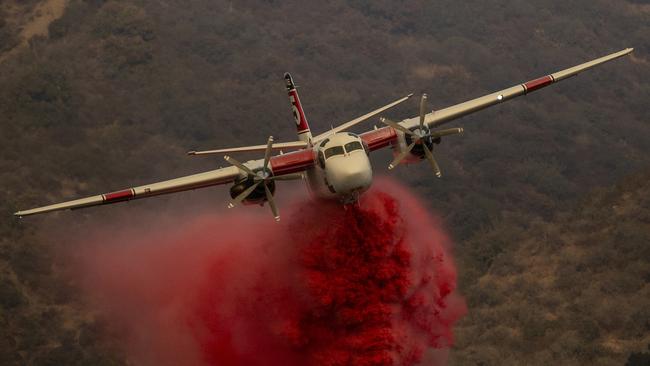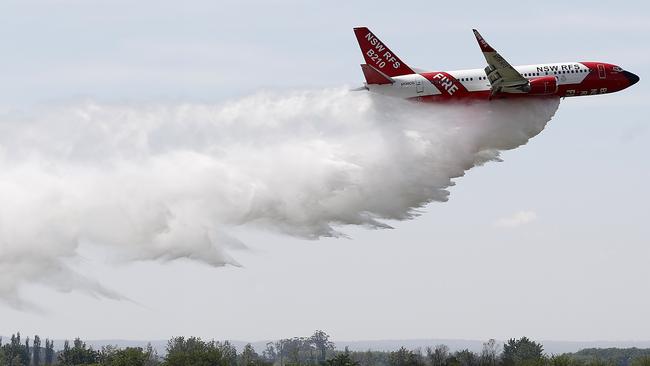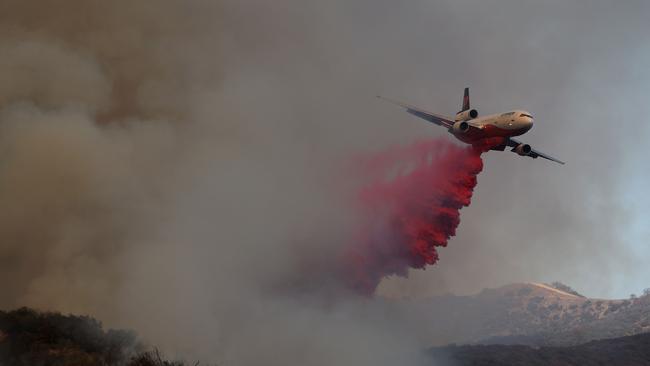Australia warned to develop sovereign firebombing capacity beyond leased US firebombers as LA winter wildfires burn during our summer
Australia has been given a crucial reminder that overlapping global fire seasons mean we can no longer rely on global sharing arrangements for waterbombing aircraft as winter wildfires continue to tear through Los Angeles.

Firefighters, environmental groups and experts warn overlapping global fire seasons leave Australia’s leasing of shared waterbombing aircraft in greater doubt, as bushfires tear through Los Angeles and the threat remains high in this country.
Australia has about 170 aircraft contracted for firefighting operations and the capacity to lease more to meet peak demands. Of those 170, seven are Large Air Tankers for firebombing, with only one Australian-owned – by the NSW Rural Fire Service. The others are leased from North America during their winter.
Traditionally resources have been shared between firefighting agencies around the globe, notably American firefighters assisted during our Black Summer bushfires. But simultaneous fire seasons are putting this under threat.

This has led to warnings that Australia needs to bolster its own aerial firefighting capacity. The commissioner of NSW’s Rural Fire Service, Rob Rogers, said Australia’s needs in terms of sovereign capability needed to be considered to make sure people were protected “irrespective” of where they were in the country.
“Now whether that means we buy more aircraft or we use a long-term dedicated lease and have a longer time, the risk for us is when you have something that comes here for a few months and goes there for a few months and they earn more money over there, then that’s going to be the risk for us,” he said.
The warnings came as an Australian man was confirmed killed in the Palisades fire that continues to devastate Los Angeles.
Rory Callum Sykes, 32, was living with his mother Shelly Sykes, who said she was totally heartbroken after her son was killed when the fire burnt through his cottage on their Mount Malibu estate.
“It is with great sadness that I have to announce the death of my beautiful son,” she said on social media.
Dr Sykes said her son was born blind and with cerebral palsy and “overcame so much” through surgeries and therapies that helped him regain his sight and learn to walk.
NSW Premier Chris Minns said it was “every parent’s worst nightmare” and that he was heartbroken that Mr Sykes had lost his life in the fires.
“It’s a reminder that these natural disasters don’t pay any heed to who you are or where you’ve come from,” he said.
Mr Sykes was born in West Yorkshire in the UK and worked briefly as a child actor and model in his youth. He described himself as a “well-travelled gamer turned investor and entrepreneurial philanthropist, a professional speaker who loves to play RuneScape and dabble in code”.
Dr Sykes told 10 News that her son had “died needlessly” after he became trapped in his self-contained cottage. She said she drove to the nearest fire station to get help after being unable to move him. “When the fire department brought me back, his cottage was burned to the ground,” she said.
With the devastation in LA raging, Friends of the Earth campaigns co-ordinator Cam Walker said: “As fire seasons extend in both hemispheres, we face the risk of being unable to secure leases for LATs in coming years.”
Jason Heffernan, chief executive of Victoria’s Country Fire Authority, said that on a national level fire chiefs are watching what is happening in the US, Greece and other areas around the world where Australia sources some of its firefighting fleet.
“It is one of the things that you need to monitor closely, you need to work with other states, jurisdictions, countries to make sure it lines up as best we can,” he said.
“Every now and then you are going to have these overlap events.”

Emergency Management Minister Jenny McAllister told Sky News the government had invested $48m to secure a LAT and three heavy-lift-helicopters that could help with aerial firefighting. But this was still below the seven LATs needed in Australia during a difficult fire season.
“We need to step up the volume and the availability of aircraft and that’s why we’ve made the investments we have,” she said.
“We did so on the advice of the fire chiefs and we constantly work with them to ensure that we’re securing the kind of assets that are appropriate for the conditions that present at the time.
“To date, the advice has been that the leasing arrangements we’ve had are the best way to secure a sufficiently flexible fleet to meet a changing fire environment. But we do need to assess and review that. We’ve commissioned a review. It’s under way and we expect to receive the results from that this year.”






To join the conversation, please log in. Don't have an account? Register
Join the conversation, you are commenting as Logout